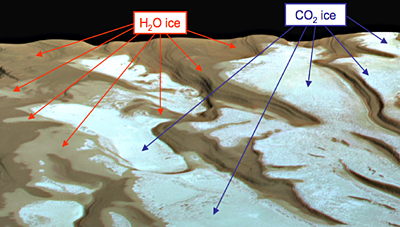New Mars Forums
You are not logged in.
- Topics: Active | Unanswered
Announcement
Pages: 1
#1 2007-06-15 00:38:56
- cIclops
- Member
- Registered: 2005-06-16
- Posts: 3,230
Re: Large Oceans on Early Mars
Research Supports Presence of Large Oceans on Early Mars
MOFFETT FIELD, Calif. – NASA-funded astrobiologists at the University of California, Berkeley have discovered evidence supporting the presence of large oceans of liquid water on early Mars.
One of the most obvious surface features on Mars is a large plain surrounding the north pole that resembles a sediment-filled ocean basin with shoreline-like features. But the purported shoreline isn’t level, an observation that has been used as an argument against the presence of an ocean. This new study shows that the undulations can be explained by movement of Mars' spin axis, and thus its poles, and that a liquid water ocean could indeed have existed there.The scientists’ research is scheduled to be published in the June 14 issue of Nature magazine.
“This work strongly supports the idea that there were large standing bodies of water on the Martian surface,” said Carl Pilcher, director of the NASA Astrobiology Institute at NASA Ames Research Center, Moffett Field, Calif., which co-funded the study. “Interpreting this topography as an ancient northern ocean could have a great impact on current and future Mars exploration,” he added.
"When the spin axis moves relative to the surface, the surface deforms, and that is recorded in the shoreline," said study co-author Michael Manga, a professor of Earth and planetary science at UC Berkeley, and member of the NASA Astrobiology Institute Team there. "On planets like Mars and Earth that have an outer shell or lithosphere that behaves elastically, the solid surface will deform differently than the sea surface, distorting the topography," added primary author Taylor Perron, a former UC Berkeley graduate student, now a postdoctoral fellow in Harvard University's Department of Earth and Planetary Sciences. Perron's calculations show that the resistance of the elastic crust could create elevation variations for topographic features like the shoreline, in accord with observations.
Perron, Manga and their colleagues calculate that on Mars, an initial shift of 50 degrees from today's pole would be sufficient to disrupt the shoreline. Manga theorizes that the shift that precipitated the tilt of Mars' rotation axis is related to the presence (and great mass) of an ocean at one of the poles. If a flood of water had filled an ocean at the northern pole on Mars about 3 billion years ago, its mass might have been enough to shift the pole 50 degrees to the south. Once the water disappeared, the pole could have shifted back.
Manga also said the source of the water, while unknown, may have produced a flood or deluge greater than any that have been observed on Earth, evidenced by huge canyons in the flanks of the Tharsis rise, site of the solar system’s largest volcano.The water may have evaporated, but it may also have sunk back into underground dikes, frozen near the surface but possibly liquid below.
Elegant explanation for the different "shorelines" and the massive water flows.
[color=darkred]Let's go to Mars and far beyond - triple NASA's budget ![/color] [url=irc://freenode#space] #space channel !! [/url] [url=http://www.youtube.com/user/c1cl0ps] - videos !!![/url]
Offline
Like button can go here
#2 2007-07-21 11:00:57
- cIclops
- Member
- Registered: 2005-06-16
- Posts: 3,230
Re: Large Oceans on Early Mars

Different types of ice deposits present in the South polar cap (MEX/HRSC)
The origin of perennial water-ice at the South Pole of Mars - 13 Jul 2007
Franck Montmessin, from the Service d'Aéronomie du CNRS/IPSL (France) and lead author of the findings, explains how the deposits of water ice at the Martian's poles 'behave'. "We believe that the deposits of water-ice are juggled between Mars’ North and South Poles over a cycle that spans 51 000 years, corresponding to the time span in which the planet's precession is inverted." Precession is the phenomenon by which the rotation axis of a planet wobbles.
Montmessin and colleagues came to the conclusion by turning back time in their Mars climate computer model. This was done by changing the precession together with other orbital information.
The scientists set the clock 21 000 years back, when the closest vicinity of the planet to the Sun corresponded to the northern summer – a situation opposite to that of today.
The model has shown that water at the North Pole was in an unstable condition and was easily transported to the South Pole in the form of water vapour, to then re-condense and freeze on the surface. Up to 1 millimetre of water ice was deposited at the South Pole every year. After Mars has spent more than 10 000 years in that climatic configuration, this accumulation led to a layer up to 6-metre thick.
About 10 000 years ago the precession cycle was inverted, and started to return to its current configuration. Water-ice at the South Pole became unstable, and was forced to progressively return back to the North.
[color=darkred]Let's go to Mars and far beyond - triple NASA's budget ![/color] [url=irc://freenode#space] #space channel !! [/url] [url=http://www.youtube.com/user/c1cl0ps] - videos !!![/url]
Offline
Like button can go here
Pages: 1